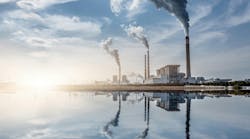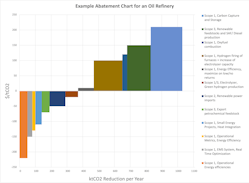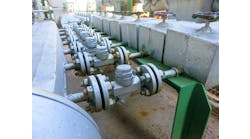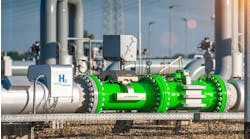In the ongoing global effort to combat climate change, industries increasingly focus on reducing their carbon footprint. Chemical plants and oil refineries that are significant contributors to greenhouse gas emissions are exploring various strategies to mitigate their environmental impact. One powerful tool in this strategy is the abatement curve, a graphical representation that helps organizations prioritize and implement emission reduction measures efficiently.
An abatement curve, also known as a mitigation cost curve, illustrates the cost-effectiveness of different emission reduction strategies within a specific industry or sector. In the context of chemical plants and oil refineries, it outlines the relationship between the level of emissions abatement and the associated costs for implementing various technologies or practices. Chemical plant managers can use abatement charts to identify the most cost-effective strategies for reducing emissions. By analyzing the curve, decision-makers can pinpoint the options that offer the most significant emissions reductions for a given investment. This enables companies to allocate resources more efficiently, focusing on measures that yield significant environmental benefits at a reasonable cost and plan investments for further emission reductions based on the company’s sustainability goals.
Figure 1 below shows a typical abatement chart for an oil refinery.
In this abatement chart, the left side displays projects that positively contribute to the oil refinery’s operating margin. These projects can be implemented profitably, improving refining margins and reducing carbon emissions. These projects include energy efficiency improvements, installing an energy management system (EMS), developing energy metrics for operators and engineers, real-time optimization (RTO) of the utility systems, and better awareness of the plant's energy efficiency and carbon emissions efforts. This will reduce emissions typically 20% to 30%.
Projects listed on the right actually cost the oil refinery. They are typically implemented because of a corporate commitment to “net-zero” or local regulations that require the oil refinery to reduce emissions. These projects include electrification of equipment like furnaces, green hydrogen production and its use as a fuel, and carbon capture and storage projects. Subsidies may be available through the Inflation Reduction Act to make such projects more beneficial.
Potential Emission Reduction Projects
Reducing greenhouse gas emissions in an oil refinery involves implementing a combination of projects and initiatives across various aspects of the facility. These projects aim to enhance energy efficiency, optimize processes and integrate cleaner technologies. Below is a list of project types commonly undertaken in oil refineries to combat greenhouse gas emissions.
1. Energy Efficiency Improvements
- Upgrade and optimize heat exchangers for better energy recovery.
- Implement advanced process control systems to enhance energy efficiency.
- Conduct regular energy audits to identify and address inefficiencies.
- Address issues with insulation and steam losses.
- Implement an energy management system (EMS) and potentially a real-time optimizer (RTO) for the utility system.
2. Flare Gas Recovery
- Install flare gas recovery systems to capture and utilize gases typically flared during routine operations.
- Utilize recovered gases for on-site power generation or other processes.
3. Carbon Capture and Storage (CCS)
- Implement carbon capture technologies to capture CO2 emissions from various sources within the refinery.
- Explore options for storing or utilizing captured CO2 to prevent its release into the atmosphere.
4. Renewable Energy Integration
- Incorporate renewable energy sources, such as solar or wind power, into the refinery's energy mix.
- Evaluate the feasibility of on-site renewable energy generation to supplement traditional energy sources.
5. Hydrogen Production and Integration
- Investigate the production of hydrogen through cleaner methods, such as electrolysis or steam methane reforming with carbon capture.
- Utilize hydrogen as a cleaner feedstock or fuel in various refinery processes.
6. Process Optimization
- Implement advanced process optimization technologies to enhance overall operational efficiency.
- Upgrade or retrofit existing units to improve their environmental performance.
7. Catalyst Upgrades
- Upgrade catalysts in key refinery processes to improve efficiency and reduce emissions.
- Explore innovative catalyst technologies that promote cleaner and more sustainable operations.
8. Waste Heat Recovery
- Implement waste heat recovery systems to capture and reuse excess heat generated during refinery processes.
- Utilize recovered heat for other industrial processes or for on-site power generation.
- Consider utilizing heat pumps, district heating, desalination and other processes that utilize low-level heat.
9. Electrification of Processes
- Evaluate the feasibility of electrifying certain refinery processes that traditionally rely on fossil fuels.
- Utilize electric heating or electric drives in specific applications to reduce emissions.
10. Fuel Switching
- Transition to cleaner fuels with lower carbon content in the refining process.
- Explore alternative feedstocks that have a lower environmental impact.
11. Monitoring and Reporting Systems
- Install real-time monitoring and reporting systems to track emissions and identify areas for improvement.
- Implement continuous emissions monitoring to ensure compliance with environmental regulations.
12. Employee Training and Awareness Programs
- Develop training programs to educate refinery personnel on sustainable practices and the importance of emissions reduction.
- Foster a culture of environmental responsibility among employees.
- Implement metrics that will display best practices and support operators to minimize energy usage.
13. Investment in Research and Development
- Allocate resources to research and development initiatives aimed at discovering and implementing innovative technologies for emissions reduction.
- Collaborate with industry partners, research institutions, and technology providers to stay at the forefront of sustainable practices.
14. Supply Chain Optimization
- Work with suppliers to source materials and products with lower carbon footprints.
- Optimize transportation and logistics to reduce emissions associated with the supply chain.
- Consider increase of exporting materials like asphalt, bitumen and petrochemical feedstocks, that will not be used as fuel.
Implementing a combination of these projects, tailored to the specific characteristics of each refinery, can contribute significantly to reducing greenhouse gas emissions and enhancing the overall sustainability of oil refining operations.
In the pursuit of emissions reduction, abatement curves can be an indispensable tool. They offer a holistic view of the costs and benefits associated with different strategies, enabling organizations to make informed decisions, set realistic goals and adapt to a rapidly evolving landscape. As the global community intensifies its efforts to combat climate change, the strategic use of abatement curves will play a pivotal role in steering the chemical industry toward a more sustainable and environmentally conscious future.




